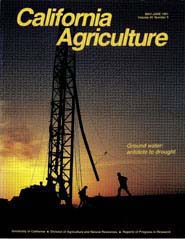


University of California
California Agriculture
|
|||
|
|||

Ground water: antidote to drought
Cover:
At dawn, drill crew extends the drill pipe to complete a 440-foot deep irrigation well near Davis.
Photo by Jack Kelly Clark
May-June 1991
Volume 45, Number 3 News and opinion |
|||
|
University of California, 1301 S. 46th St., Bldg. 478 Richmond, CA
|